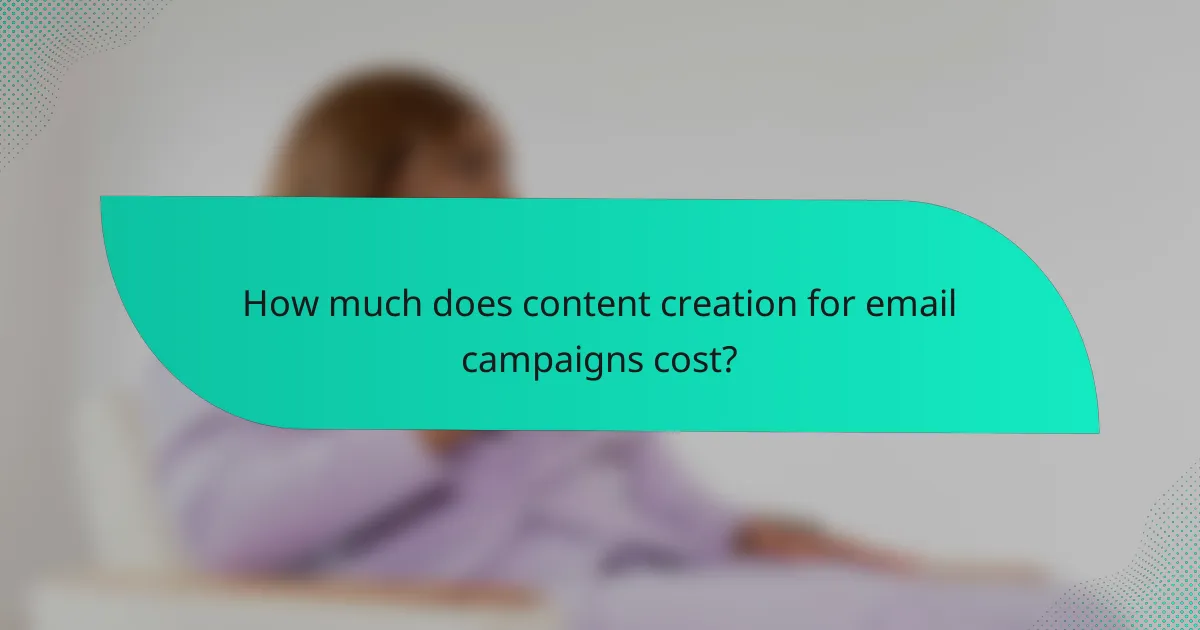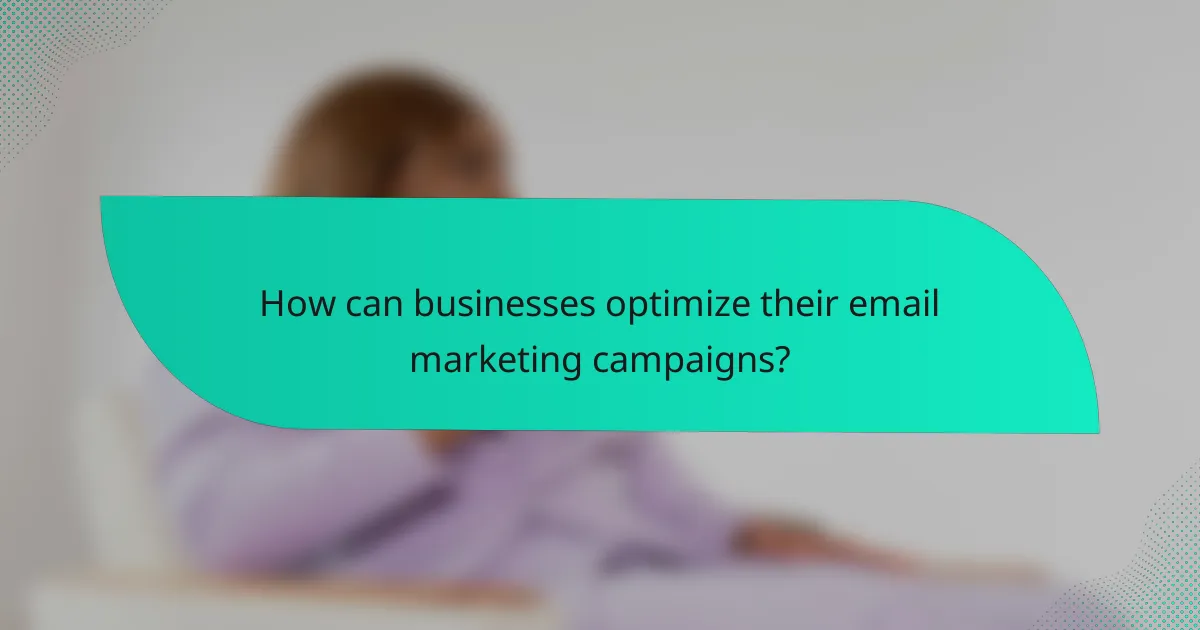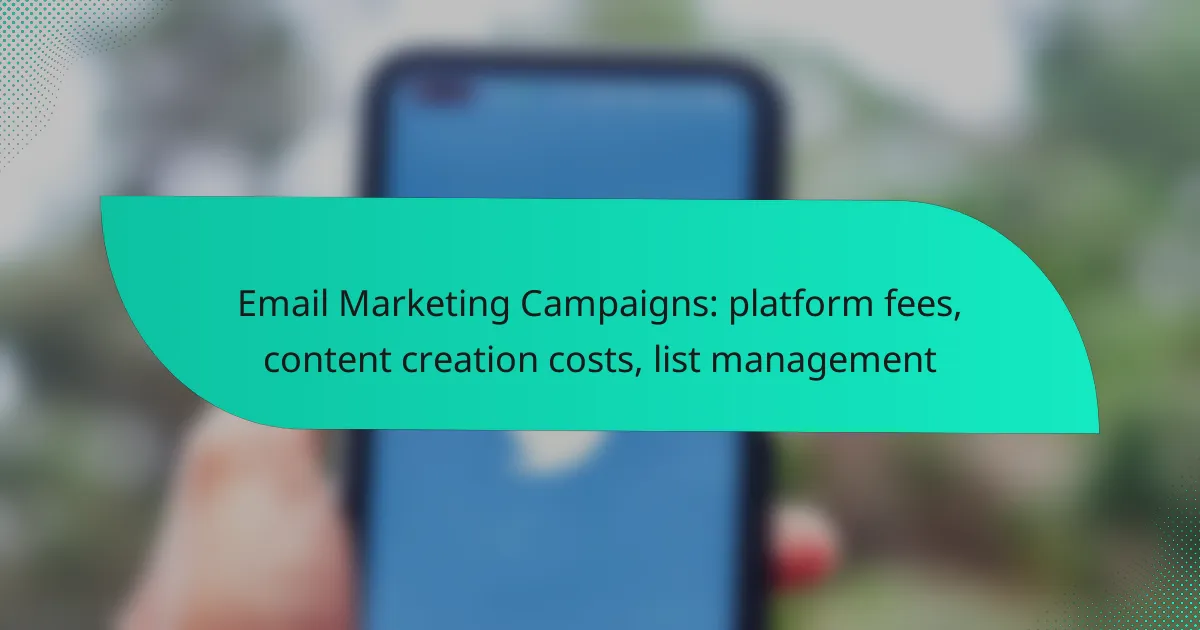Email marketing campaigns can incur various costs, including platform fees based on subscriber numbers and desired features, which can range from free to hundreds of pounds monthly. Additionally, content creation expenses vary significantly, often costing from a few hundred to several thousand dollars depending on the project’s complexity and the creator’s expertise. Effective list management is crucial for maximizing engagement and compliance, requiring practices such as audience segmentation and regular data cleansing.

What are the costs of email marketing platforms in the UK?
Email marketing platforms in the UK typically charge based on the number of subscribers and the features included. Costs can vary significantly, ranging from free basic plans to premium options that may cost hundreds of pounds per month, depending on the service provider and the level of functionality required.
Mailchimp pricing tiers
Mailchimp offers several pricing tiers, including a free plan for up to 2,000 contacts and 10,000 email sends per month. Paid plans start at around £10 per month, increasing based on the number of subscribers and additional features such as advanced analytics and automation tools.
Consider the features you need when choosing a plan. For small businesses, the Essentials plan may suffice, while larger organizations might benefit from the Standard or Premium tiers, which offer more advanced capabilities.
Constant Contact fees
Constant Contact has a straightforward pricing structure with plans starting at approximately £15 per month for up to 500 subscribers. As your list grows, the cost increases, with options for additional features like social media posting and event management.
It’s essential to evaluate the features included in each plan. For example, the Email Plus plan, which costs around £30 per month, includes tools for automation and surveys, making it suitable for businesses looking to engage their audience more effectively.
Sendinblue pricing structure
Sendinblue’s pricing is based on the number of emails sent rather than the number of subscribers. Their free plan allows for up to 300 emails per day, while paid plans start at about £19 per month for 10,000 emails. This model can be beneficial for businesses with large lists but lower email frequency.
When selecting a plan, consider your email volume and marketing strategy. The Premium plan, which costs around £49 per month, includes additional features like advanced reporting and marketing automation, which can enhance your campaigns significantly.

How much does content creation for email campaigns cost?
The cost of content creation for email campaigns can vary widely based on the type of content, the creator’s expertise, and the complexity of the project. Generally, businesses can expect to spend anywhere from a few hundred to several thousand dollars depending on their specific needs and goals.
Freelance copywriter rates
Freelance copywriters typically charge between $50 and $150 per hour, depending on their experience and the project’s complexity. Some may offer flat rates for specific tasks, such as writing email sequences or promotional content, which can range from $200 to $1,000 for a complete campaign.
When hiring a freelancer, consider their portfolio and client reviews to ensure they align with your brand voice and objectives. It’s often beneficial to discuss your budget upfront to find a suitable arrangement.
In-house content creation expenses
In-house content creation can incur various costs, including salaries, benefits, and tools for your team. Hiring a full-time copywriter may cost between $40,000 and $80,000 annually, depending on the location and level of expertise.
Additionally, consider the costs of training and software subscriptions for email marketing tools, which can add to your overall expenses. Balancing in-house resources with freelance support might provide flexibility and cost-effectiveness.
Graphic design costs for email templates
Graphic design for email templates can range from $100 to $1,500 per template, depending on the designer’s experience and the complexity of the design. Simple, pre-made templates can be purchased for as low as $20, while custom designs will naturally be more expensive.
When budgeting for graphic design, factor in the need for responsive designs that work well on both desktop and mobile devices. Investing in high-quality visuals can significantly enhance engagement rates and overall campaign effectiveness.

What are the best practices for list management in email marketing?
Effective list management in email marketing involves organizing and maintaining your subscriber list to enhance engagement and compliance. Key practices include segmenting your audience, regularly cleansing your data, and adhering to relevant regulations like GDPR.
Segmentation strategies
Segmentation strategies involve dividing your email list into smaller groups based on specific criteria such as demographics, behavior, or purchase history. This allows for more targeted messaging that resonates with each segment, improving open and click-through rates.
Common segmentation criteria include geographic location, past purchase behavior, and engagement levels. For example, you might send promotional offers to frequent buyers while providing re-engagement campaigns to inactive subscribers.
Data cleansing techniques
Data cleansing techniques are essential for maintaining a healthy email list. Regularly remove invalid email addresses, duplicates, and unsubscribed users to ensure your campaigns reach engaged recipients. This practice can significantly improve your deliverability rates.
Consider implementing automated tools that can help identify and remove inactive subscribers. A good rule of thumb is to clean your list at least once every few months to keep it fresh and relevant.
Compliance with GDPR regulations
Compliance with GDPR regulations is crucial for any email marketing campaign targeting individuals in the European Union. Ensure that you have explicit consent from subscribers before sending marketing emails and provide clear options for them to opt-out at any time.
Additionally, maintain transparency about how you collect, store, and use subscriber data. Regularly review your practices to ensure they align with GDPR requirements, as non-compliance can result in significant fines and damage to your brand’s reputation.

What factors influence email marketing platform selection?
When selecting an email marketing platform, key factors include integration capabilities, user experience, pricing structures, and the specific needs of your campaigns. Understanding these elements helps ensure that the chosen platform aligns with your business goals and enhances your marketing efforts.
Integration capabilities
Integration capabilities refer to how well the email marketing platform connects with other tools and systems you use, such as CRM software, e-commerce platforms, and analytics tools. A platform that seamlessly integrates can streamline your workflow, allowing for better data management and more effective marketing strategies.
Look for platforms that offer a wide range of integrations, particularly with tools you already use. For example, platforms like Mailchimp and HubSpot provide extensive integration options, making it easier to sync customer data and automate processes.
User interface and experience
The user interface (UI) and overall user experience (UX) of an email marketing platform significantly impact how effectively you can create and manage campaigns. A clean, intuitive UI allows users to navigate the platform easily, reducing the learning curve and enabling quicker campaign launches.
When evaluating platforms, consider features such as drag-and-drop editors, customizable templates, and mobile responsiveness. Platforms like Constant Contact and Sendinblue are known for their user-friendly interfaces, which can enhance your productivity and creativity in designing emails.

How can businesses optimize their email marketing campaigns?
Businesses can optimize their email marketing campaigns by focusing on effective strategies such as A/B testing, personalization, and efficient list management. These methods help improve engagement rates, enhance customer experience, and ultimately drive conversions.
A/B testing methods
A/B testing, or split testing, involves sending two variations of an email to different segments of your audience to determine which performs better. Key elements to test include subject lines, email layouts, call-to-action buttons, and sending times. By analyzing open rates and click-through rates, businesses can refine their approach based on data-driven insights.
When conducting A/B tests, ensure that each test is run for a sufficient duration to gather reliable data, typically a few days to a week. Avoid testing too many variables at once, as this can complicate the analysis. Instead, focus on one element at a time to clearly understand its impact on performance.
Personalization techniques
Personalization in email marketing involves tailoring content to individual recipients based on their preferences, behaviors, and demographics. This can include using the recipient’s name, recommending products based on past purchases, or sending targeted offers based on location. Personalized emails can significantly increase engagement and conversion rates.
To implement effective personalization, segment your email list based on criteria such as age, purchase history, or engagement level. Utilize customer data to create relevant content that resonates with each segment. However, be cautious not to over-personalize, as this can come off as intrusive and may lead to unsubscribes.

What emerging trends are shaping email marketing in the UK?
Emerging trends in email marketing in the UK focus on enhancing user engagement and personalization. Key developments include the use of AI for content generation, interactive features in emails, and a strong emphasis on mobile optimization.
AI-driven content generation
AI-driven content generation is transforming how marketers create email campaigns. Tools powered by artificial intelligence can analyze customer data to produce tailored content that resonates with specific audience segments.
These AI tools can generate subject lines, body text, and even personalized recommendations based on user behavior. This not only saves time but also increases the relevance of the emails sent, potentially boosting open and click-through rates.
Interactive email features
Interactive email features are becoming increasingly popular, allowing recipients to engage directly within the email itself. Elements such as polls, quizzes, and embedded videos can enhance user experience and encourage immediate responses.
Incorporating interactive features can lead to higher engagement rates, as users are more likely to interact with content that is dynamic and visually appealing. However, it’s essential to ensure that these features are compatible across various email clients to avoid rendering issues.
Increased focus on mobile optimization
With a significant portion of emails being opened on mobile devices, optimizing email campaigns for mobile is crucial. This includes using responsive design to ensure emails display correctly on different screen sizes and simplifying content for quick reading.
Marketers should prioritize concise messaging and clear calls to action that are easily clickable on mobile screens. Testing emails on various devices before sending can help identify any issues that could hinder user engagement.
